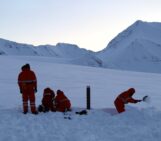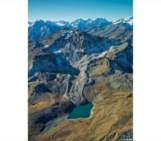
Ice can be slippery! [Credit: giphy.com]
Having spent most of my life in places where the temperature hardly ever falls below zero, my first winter in Sweden was painful. Especially for my bum, who met the ice quite unexpectedly. Reading the news this week, from reports of emergency services overwhelmed after so many people had slipped to a scientific study on how no shoes have a good enough grip, via advice on how to walk like a penguin, I understand I am far from alone in having a problem with ice. But why is ice so slippery anyway? This is what we will talk about in this Image of the Week.
Did you know that you lacked friction?
To understand why one might fall sometimes, let us start with why one usually can walk without falling: friction! Friction is a resistive force that can have three causes:
-
Adhesion (think about glue or tape)
-
Surface roughness (think about sandpaper)
-
Deformation (think about dragging a suitcase over a gravel path)
Each of these types of friction is nicely explained on this website, so I will concentrate on our walking question. Note that if you are standing still, it is a different story; then we are talking about static (instead of dynamic) friction. And everything is actually a bit more complicated than the distinction between the three causes, since adhesion and roughness are somehow related. I will not get into that, but if that stirred your interest, you could have a look at this paper. Anyway, back to walking.
The roughness of our roads and pavements, along with that of your shoes and their deformation ability, is, of course, crucial. But in the case of water after the rain or rotten autumn leaves, adhesion can be the deciding factor between casually walking and experiencing a sudden unexpected loss of altitude: not that much adhesion between your foot and what you walk on, but rather between what you walk on and the rest of the world. And that is exactly the problem with ice.

Frozen lake [Credit: Nilay Dogulu (distributed via imaggeo.egu.eu)]
Water really is a weird material
Coming from a place where people rarely worry about ice, I had never heard the commonly accepted reasons why ice is slippery. A quick internet search informed me that a common belief is that ice is slippery because, by walking on it, we melt the very surface of the ice through the pressure of our weight and/or the heat of the friction. As a result, we end up with a dangerous layer of liquid water between our foot and the ice, lose adhesion, and … boom! A study published this summer has a different explanation: water in its solid form is made of chains of molecules attached to three other water molecules. But the chain has to stop somewhere, so, at the very surface, molecules are only attached to one or two others, and can, as a result, be easily detached from the rest of the ice. When that happens, they just hang around on top of the ice, “like marbles on a dancefloor“.
However, it cannot be seen as a layer of liquid water, rather as a gas, the authors of that new study say. Not that it makes a big difference when you are on the floor… The good (?) news is, this strange property of ice depends on temperature. They report that ice is the most treacherous at -7°C, but then becomes safer as the temperature decreases.
EGU Cryosphere friendly advice: how to walk around -7°C
Personally, I avoid roads and pavements like the plague and walk on frozen paths and grass, which retain some roughness unless covered by a lot of snow. Since it is not always possible, adopt the technique of our favourite polar animal:
-
put your centre of mass ahead of you by slightly bending your torso forward
-
go slowly
-
move your foot next to each other, instead of in front of one another
-
or give up and slide on your belly!

One of our favourite polar animals [Credit: Giuseppe Aulicino (distributed via imaggeo.egu.eu)].
Further reading
-
Weber B., Nagata Y., Ketzetzi S., Tang, F., Smit W.J., Bakker H.J., Backus E.H.G., Bonn M., and Bonn D. (2018): Molecular Insight into the Slipperiness of Ice. J. Phys. Chem. Lett., 9(11), pp 2838–2842, doi: 10.1021/acs.jpclett.8b01188.
- Image of the Week – How hard can it be to melt a pile of ice?!
Edited by Clara Burgard




